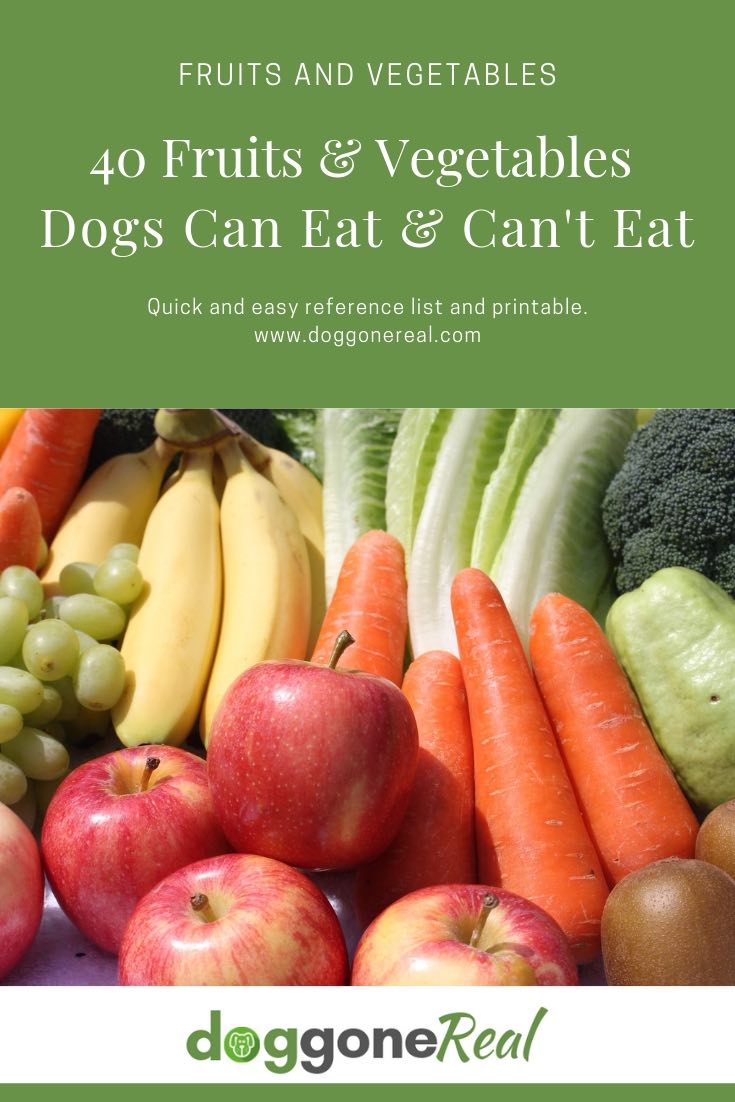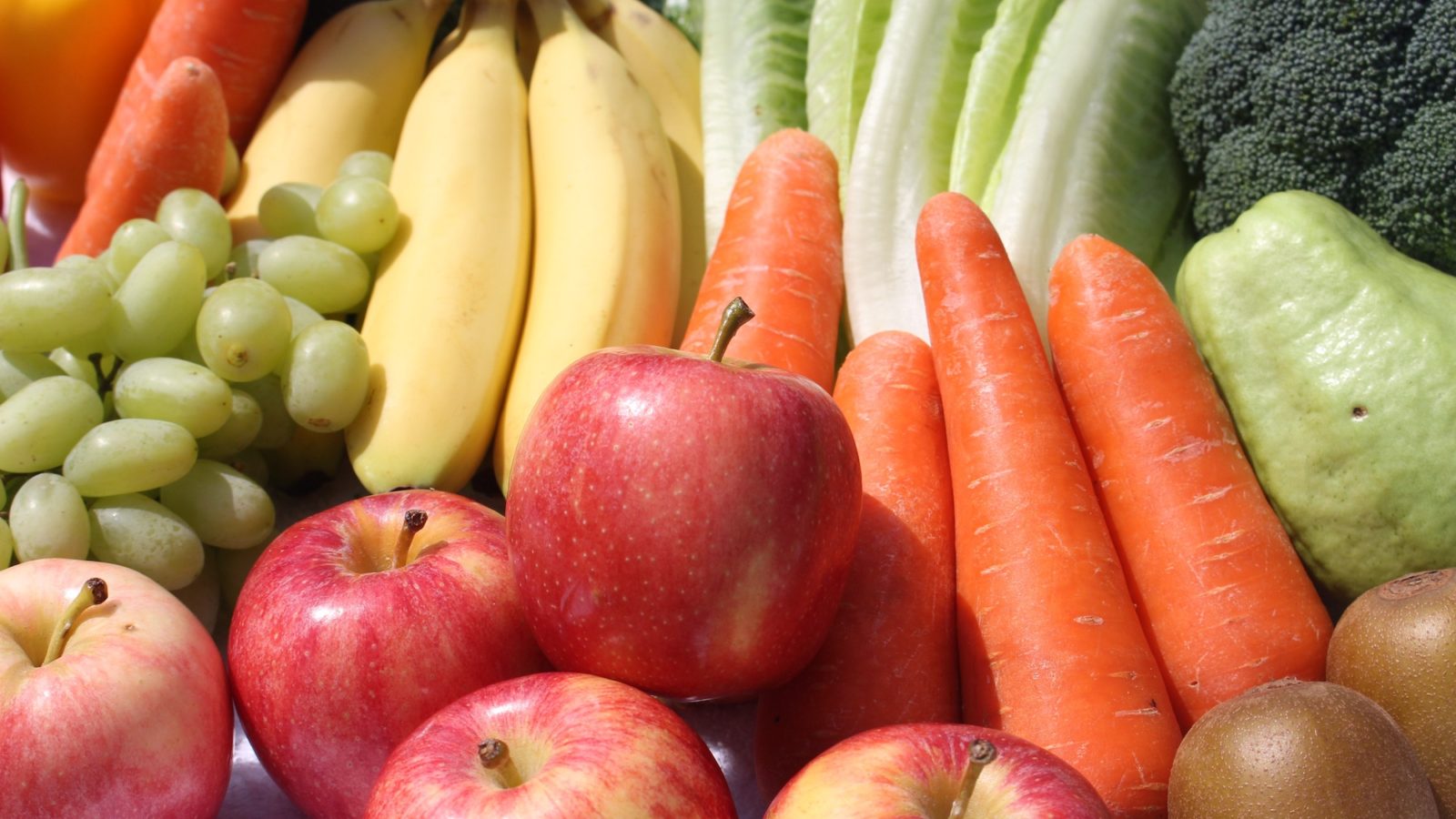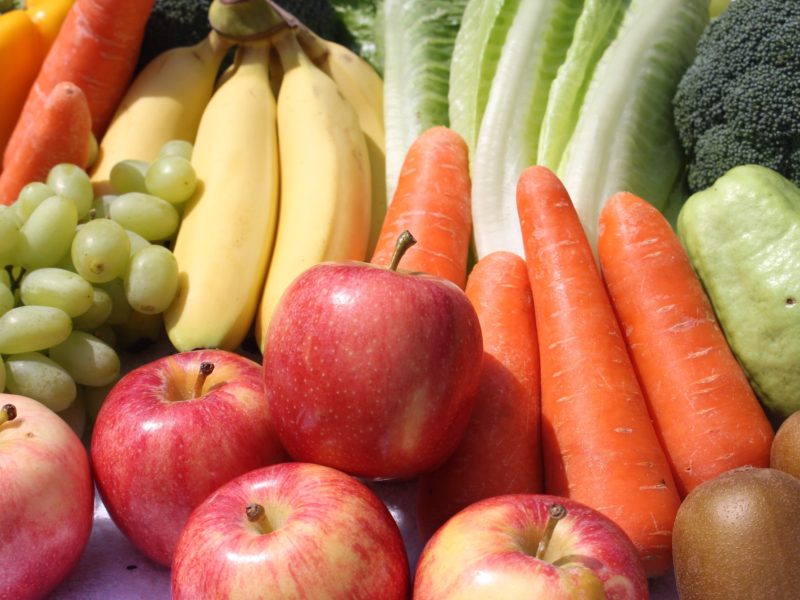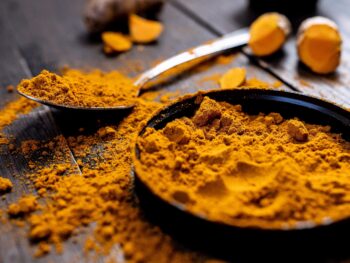It’s important to know which fruits and vegetables are safe and healthy for your dog and which ones should be avoided. Our list of the 40 Fruits and Vegetables Dogs Can Eat and Can’t Eat provides a quick, easy reference to get it right.
In This Article
The Great Debate – Should Dogs Eat Fruit and Vegetables?
Feeding vegetation to dogs is greatly debated and is an individual decision you should make for you and your dog after doing thorough research and discussing things with your vet.
The short version:
- Prey feeders don’t think fruit and vegetable play a role in the diet.
- BARF feeders include vegetation in the dog diet.
Personally, I’ve always fed my dogs appropriate fruit dogs can eat and vegetable dogs can eat within the suggested dietary guidelines. Some they love and can’t get enough of and others have been left in the bowl just like kids who have different eating preferences.
The Rationale for Including Fruit and Vegetables in Your Dogs Diet
- There is evidence that vegetation has been found in the scat of some wolves that have been studied. This suggests that plants are a part of the primordial diet. Read more about the Ancestral Link and Why Raw Feeding is What your Dog Wants Naturally.
- Dogs have adapted to use them.
- They are not an essential macronutrient but provide many benefits.
Benefits for Dogs of Eating Fruit and Vegetables
- This is a great way to supplement your dog’s diet for added nutritional benefits.
- Vegetation contains phytonutrients – plants that help fight or prevent disease.
- Yellow, orange, and red-colored fruit and vegetables contain carotenoids which act as antioxidants.
- Lycopene, a powerful antioxidant is found in carrots, cabbage.
- Lutein, a powerful protector for the eyes, skin, and heart is found in leafy dark greens and yellow plants such as kale, broccoli, oranges, and papaya.
- Flavonoids can regulate cells – have anti-inflammatory properties
- Fiber is found in fruits and vegetables which bulks up food to help it pass through the colon.
- Soluble fiber can be prebiotic and feeds good bacteria to the gut.
How Many Fruits and Vegetables Should Dogs Eat?
Fruits and vegetables should comprise about 5-10% of your dog’s diet:
- Low end: 4%
- Plenty: 5-10%
- Max: 10-15%
Organic versus Non-Organic?
Organic produce is the best bet to avoid pesticides and heavy metals. However, if you can’t afford to buy organic all the time, you can refer to the Clean 15 and Dirty Dozen List to understand the dirtiest produce that’s covered in pesticides – these you should definitely buy organic.
How to Prepare the Fruit and Vegetable for Dogs?
Dogs don’t have the teeth, jaw structure, or salivary enzymes to begin the digestion process in the mouth, therefore, it’s best to provide some type of pre-digestion for fruits and more importantly vegetables before they are fed to dogs.
How can this be done?
1. Purée them. The more finely you puree them, the more nutrients they will get from them. I use my Ninja Blender with the various-sized cups that I can blend in. This is very handy as I don’t need to use the big 72-ounce pitcher each time.
2. Ferment them to ensure the best nutrient absorption. Fermenting vegetables makes them even more healthy and it makes the minerals, vitamins, and enzymes in vegetables more digestible. Fermenting also increases the number of probiotics (good bacteria) in the gut.
3. Steam or cook them using a mini microwave steamer which makes steaming a snap and cleanup is quick, however, cooking causes some nutrient loss.
About Our List of Fruits and Vegetables for Dogs
Not all fruits and vegetables are healthy for dogs. We’ve grouped our list of 40 fruits and vegetables into three groups:
- YES – Best fruits and best vegetables for dogs. These are fruits and vegetables good for dogs.
- CAUTION – OK to eat in smaller quantities. Some cautionary suggestions exist regarding preparation, seeds, skin, etc.
- NO – These are either toxic to dogs or for various stated reasons are best to be avoided.
40 Fruits and Vegetables Dogs Can Eat and Ones that Should be Avoided:
YES – Fruits and Vegetables Dogs CAN EAT:
The fruits and vegetables listed below are great for dogs. They add nutrients and dietary fiber and can be added to your dog’s meal in small quantities or used as a healthy treat. These human food options are much healthier dog treats than store-bought varieties.
 1. APPLES – Apples are a great source of vitamins A and C. They are high in fiber and low in protein and fat. Caution: Just remove the apple seeds and core first. Apple seeds can be toxic.
1. APPLES – Apples are a great source of vitamins A and C. They are high in fiber and low in protein and fat. Caution: Just remove the apple seeds and core first. Apple seeds can be toxic.
2. BANANAS – Dogs can eat bananas in moderation due to higher sugar content. They are low in cholesterol & sodium and high in potassium, biotin, fiber, and copper.
3. BELL PEPPER – (red, green, yellow) – Red is best. All provide beta carotene, fiber, and antioxidants. Cut into small pieces and feed with stem removed to boost immune function.
4. BLUEBERRIES – Blueberries are a superfood packed with fiber and rich in antioxidants, which prevent cell damage in humans and canines alike.
5. CANTALOUPE – Cantaloupe is OK for dogs in moderation as it is higher in sugar. Cantaloupe is low in calories, full of nutrients, and a great source of water and fiber.
6. CARROTS – They are high in fiber and beta-carotene, rich in vitamin B6, and crunching on this orange veggie is great for your dog’s teeth. But, a carrot is higher in sugar so feed in moderation.
7. CELERY – Celery contains vitamins A, B, and C, promotes a healthy heart, and even fights cancer. Plus, it freshens doggy breath. Just remember, everything in moderation as too much can cause increased urination in some dogs.
More Vegetables and Fruits Dogs CAN EAT
8. CUCUMBERS – Cucumbers are great. They are low in fats, oils & carbohydrates, and high in vitamin K, vitamin C, vitamin B1, potassium, copper, magnesium, and biotin and can boost energy.
9. GREEN BEANS – All types of green beans are safe for dogs, are full of important vitamins and minerals, and green beans also full of fiber and low in calories.
10. MANGOS – Dogs can eat mangoes as they are full of vitamins A, B6, C, E and also have potassium, beta-carotene, and alpha-carotene, but remove the pit.
11. ORANGES – Oranges are a great source of vitamin C, potassium, folic acid, and fiber. This citrus fruit has great immunity-boosting benefits. Serve in smaller quantities. Caution: Remove the peel and seeds first.
12. PEACHES -Small amounts cut up are fine and are a great source of fiber, vitamin A, and can help fight infections. Caution: Remove the pit as it contains cyanide.
13. PEARS – Pears are a great snack and are high in copper, vitamins C, K, and fiber. Caution: Remove the pit and seeds first, as the seeds contain traces of cyanide.
14. PEAS – Green, snow, sugar snap, garden, and English peas are all OK either fresh or frozen, but not canned due to high sodium. They’re high in protein, fiber, vitamins & minerals.
15. PINEAPPLE – Pineapple is full of vitamins, minerals, and fiber and contains bromelain, an enzyme that makes it easier for dogs to absorb proteins. Caution: Remove the prickly outside first.
But wait, there are more safe fruit and vegetable that dogs CAN EAT…
16. PUMPKIN – Pumpkin is fiber-rich and contains vitamins A, E, C, potassium, and iron, it can also ease digestion and help some cases of dog diarrhea. Fresh and canned plain pumpkin (has more fiber and is better at firming poop) are acceptable. Do NOT feed pumpkin pie filling.
17. ROMAIN LETTUCE – Dogs can eat lettuce of the romaine, arugula, and iceberg variety. It’s 90% water and it’s a low-calorie, crunchy snack. Note: dogs should not eat spinach.
18. RASPBERRIES – OK for dogs and especially senior dogs as they contain antioxidants and have anti-inflammatory properties that can help alleviate joint pain. Caution: limit to less than a cup at a time as they contain Xylitol which can be toxic to dogs.
19. STRAWBERRIES – They’re full of fiber, vitamin C and contain an enzyme that can help whiten your dog’s teeth. Strawberries are high in sugar, so give them in moderation.
20. WATERMELON – Watermelon is safe for dogs and full of vitamins A, B-6, C, and potassium. At 92% water, it provides great hydration. Caution: First, remove the rind and seeds, as they can cause intestinal blockage. Check out our article Can Dogs Eat Watermelon? Is Watermelon Good for Dogs? for complete nutritional information, a list of top health benefits, preparation techniques, watermelon dog recipes and more.
21. YELLOW SQUASH – Dogs can eat yellow squash. Don’t feed it raw. Cook the squash and always remove the seeds.
22. ZUCCHINI – They are low in fat and calories and high in fiber, vitamins, and minerals. They are full of nutrients and are one of the best vegetables to feed dogs.
CAUTION – Dog’s Can Eat These, But Prepare and Feed with Caution
These are acceptable dog fruit and dog vegetable options but feed with caution in smaller quantities as these may upset your dog’s stomach. Watch for upset stomach, gas, diarrhea, etc.
 23. BROCCOLI / BROCCOLI FLORETS- Can be eaten in very small quantities (Less than 10% per day), contains isothiocyanates which can cause gastric irritation, Member of cruciferous family – may increase chances of hypothyroidism (under-active thyroid).
23. BROCCOLI / BROCCOLI FLORETS- Can be eaten in very small quantities (Less than 10% per day), contains isothiocyanates which can cause gastric irritation, Member of cruciferous family – may increase chances of hypothyroidism (under-active thyroid).
24. BRUSSELS SPROUTS – OK in moderation. They are packed with nutrients and are an excellent source of omega 3 fatty acids. Feeding too many brussels sprouts can cause lots of gas. As a member of the cruciferous family, brussels sprouts may increase the chances of hypothyroidism.
25. CABBAGE – OK in moderation. Rich in antioxidants, aids digestion. As a member of the cruciferous family, it may increase the chances of hypothyroidism and can cause gas.
26. CAULIFLOWER – Some sources claim that the cruciferous veggie family (cauliflower included) can increase the chances of hypothyroidism. Best to avoid and eat other veggies.
27. CRANBERRIES – Cranberries and dried cranberries are safe in moderation. Caution: Don’t confuse dried cranberries with craisins, dried fruit craisins, or raisins as they are very toxic to dogs.
28. MUSHROOMS – Supermarket varieties that are safe for people are safe for pets, but a wild mushroom can be toxic for dogs so it’s better to be safe than sorry and skip out on the fungi altogether.
29. SWEET POTATO – These are nutritionally a better option than potatoes, and are OK in moderation. They’re full of nutrients, fiber, beta carotene, vitamins B-6 and C. Caution:
- Wash, peel and cook first as raw sweet potatoes can be rough on the stomach
- Skins are toxic to dogs
- Sweet potatoes are higher in starch and can spike insulin levels
NO – These Fruits and Vegetables Are TOXIC to Dogs or For Other Reasons are Foods Dogs Should Avoid
 30. ASPARAGUS – Asparagus isn’t necessarily unsafe for dogs, but it’s too tough to be eaten raw, and cooking it down loses the nutrients. Not an ideal veggie. Better options exist.
30. ASPARAGUS – Asparagus isn’t necessarily unsafe for dogs, but it’s too tough to be eaten raw, and cooking it down loses the nutrients. Not an ideal veggie. Better options exist.
31. CORN – While it is a common ingredient in most dog foods, it’s a grain and high in starch, and best avoided. Don’t feed corn on the cob as it’s hard to digest and may cause intestinal blockage.
32. KALE – Kale contains several potentially harmful natural compounds, including calcium oxalate & isothiocyanate, and can cause mild to potentially severe gastric irritation and kidney and bladder stones in some cases.
33. POTATOES – While peeled and cooked potatoes are ok on occasion, they are high in starch, can spike insulin levels, and best avoided. Never feed raw potatoes as they can be rough on the stomach, skins contain chaconine, and are toxic to dogs.
34. SPINACH – Spinach is very high in oxalic acid, which blocks calcium absorption and can lead to kidney damage if consumed in large amounts so it’s best to go with another vegetable.
35. TOMATOES – The green parts of the plant contain a toxin called solanine and if a large amount is consumed it can make a dog sick so it’s better to be safe and not feed them tomatoes.
BIG NO – Very Toxic
36. AVOCADO – The pit, skin, and leaves contain persin, a toxin that can cause vomiting and diarrhea in dogs. While the inside fruit contains lower levels of persin it is still too much.
37. GARLIC – Garlic and other members of the allium family, including onions, contain thiosulfate, which is toxic to dogs whether the products are fresh, cooked or in a dried/powdered form such as in spices
38. GRAPES – Grapes and raisins are very toxic to dogs and can lead to sudden acute kidney failure and be fatal. Skip this very dangerous food.
39. ONIONS – Onions, leeks, and chives are poisonous to most pets and can cause your dog’s red blood cells to rupture, vomiting, diarrhea, stomach pain, and nausea.
40. RAISINS – Raisins are known to be highly toxic to dogs and should not be fed to them under any circumstances as raisin toxicity can even be fatal.
FREE Printable File – Fruits and Vegetable Dogs Can and Can’t Eat
We’ve also provided an alphabetical, color-coded FREE Printable file of this handy reference chart of the fruits and vegetable dogs can eat and can’t eat:
- GREEN – YES – OK for your dog and good to eat.
- YELLOW – CAUTION – OK to eat in smaller quantities. Some cautionary suggestions exist regarding preparation, seeds, skin, etc.
- RED – NO – These are either toxic to dogs or for various stated reasons are best to be avoided.
Here’s a peek of what it looks like below:
PIN IT
 Download the Free Printable File: Fruits and Vegetable Dogs Can Eat and Can’t Eat
Download the Free Printable File: Fruits and Vegetable Dogs Can Eat and Can’t Eat
Conclusion
- Feeding your dog fruits and vegetables is a personal decision.
- Fruits and vegetables can be a healthy part of your dog’s diet and provide many benefits.
- Always discuss things with your vet prior to making any radical diet changes to your dog’s diet.
- Remember to always watch your dog carefully as you introduce new foods into their diet.
- Don’t mistakenly feed them the wrong ones and suffer the consequences by making a deadly mistake.
- Keep your printable handy and reference it often.
PIN IT

SOURCES:
https://www.dogsnaturallymagazine.com/can-dogs-eat-apples-and-25-other-human-foods-for- dogs/
Other Raw Feeding Resources:
The Ancestral Link & Why Raw Feeding is What Your Dog Wants Naturally
Benefits of Raw Dog Food – Why Raw Feeding is Better
Raw Dog Diets Explained – BARF vs Prey Raw Diet
How to Transition Your Dog to a Raw Diet
Top Raw Feeding Resources – My Go-to Favorites



 Download the Free Printable File:
Download the Free Printable File: 


 101 Fun Things to Do With Your Dog
101 Fun Things to Do With Your Dog